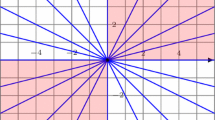Abstract
We prove a modified version for a conjecture of Weiss from 2004. Let G be a semisimple real algebraic group defined over ℚ, Γ be an arithmetic subgroup of G. A trajectory in G/Γ is divergent if eventually it leaves every compact subset, and is obvious divergent if there is a finite collection of algebraic data which cause the divergence. Let A be a diagonalizable subgroup of G of positive dimension. We show that if the projection of A to any ℚ-factor of G is of small enough dimension (relatively to the ℚ-rank of the ℚ-factor), then there are non-obvious divergent trajectories for the action of A on G/Γ.
Similar content being viewed by others
References
A. Borel, Linear Algebraic Groups, Graduate Texts in Mathematics, Vol. 126, Springer, New York, 1991.
A. Borel and J. Tits, Groupes réductifs, Institut des Hautes Études Scintifiques. Publications Mathématiques 27 (1965), 55–150.
N. Bourbaki, Lie Groups and Lie Algebras, chapters 4–6, Elements of Mathematics (Berlin), Springer, Berlin, 2002.
J. W. S. Cassels, An Introduction to Diophantine Approximation, Cambridge Tracts in Mathematics and Mathematical Physics, Vol. 45, Cambridge University Press, New York, 1957.
G. Dani, Divergent trajectories of flows on homogeneous spaces and Diophantine approximation, Journal für die Reine und Angewandte Mathematik 359 (1985), 55–89.
J. E. Humphreys, Introduction to Lie Algebras and Representation Theory, Graduate Texts in Mathematics, Vol. 9, Springer, New York-Berlin, 1978.
S. Helgason, Differential Geometry, Lie Groups and Symmetric Spaces, Pure and Applied Mathematics, Vol. 80, Academic Press, New York-London, 1978.
A. Khintchine, Über eine Klasse linearer diophantischer Approximationen, Rendiconti del Circolo Matematico di Palermo 50 (1926), 170–195.
D. Kleinbock, N. A. Shah and A. N. Starkov, Dynamics of subgroup actions on homogeneous spaces of Lie groups and applications to number theory, in Handbook of Dynamical Systems, Vol. 1A, North-Holland, Amsterdam, 2002, pp. 813–930.
A. W. Knapp, Lie Groups Beyond an Introduction, Progress in Mathematics, Vol. 140, Birkhäuser, Boston, MA, 1996.
G. A. Margulis, On the action of unipotent groups in the space of lattices, in Lie groups and their representations (Proceedings of Summer School on Group Representations, Bolyai Janos Math. Soc. Budapest, 1971), Halsted, New York, 1975, pp. 365–370.
T. A. Springer, Linear Algebraic Groups, Modern Birkhäuser Classics, Birkhäuser, Boston, MA, 2009.
G. Tomanov and B. Weiss, Closed Orbits for Actions of Maximal Tori on Homogeneous Spaces, Duke Mathematical Journal 119 (2003), 367–392.
B. Weiss, Divergent trajectories on noncompact parameter spaces, Geometric and Functional Analysis 14 (2004), 94–149.
B. Weiss, Divergent trajectories and ℚ-rank, Israel Journal of Mathematics 152 (2006), 221–227.
Author information
Authors and Affiliations
Corresponding author
Rights and permissions
About this article
Cite this article
Tamam, N. Existence of non-obvious divergent trajectories in homogeneous spaces. Isr. J. Math. 247, 459–478 (2022). https://doi.org/10.1007/s11856-021-2274-2
Received:
Revised:
Published:
Issue Date:
DOI: https://doi.org/10.1007/s11856-021-2274-2




